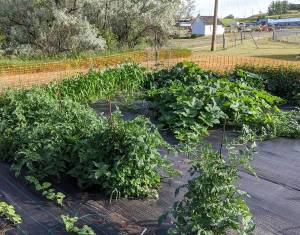Planning the Vegetable Garden

One of the first steps to planning your garden is to remember your garden from the year before. I know the drought in years past wreaked havoc on our vegetable gardens, but we can still gain some valuable insight for this year. Make sure you remember where you planted your vegetables last year. Rotating your vegetable families around the garden is important rather than planting them in the same spot year after year. The goal should be to rotate your vegetables so there are three years between when a specific vegetable was planted in that spot. For example, if I planted tomatoes in one corner of my garden last year, I should not have planted any other nightshade family member in that spot for at least three years. Something else you should remember is any disease or insect issues that might have happened in your garden. One way to keep a record of this over several years is to create a garden journal with drawings of where things were planted and any records of issues. It can also be helpful to keep track of what varieties did well and what didn’t to help for future planning.
Determining what you want to plant is the second step to planning any garden. I love this step because this is where I get to dream and look through all the pretty catalogs and the different options. Last year, our garden was relatively small, and I didn’t have room to plant much, but we have expanded this year, so I have far more room to play with. I will try to do more succession plantings to help me utilize the space I do have more efficiently. I intend to plant some cool-season crops this year in the ground and then transition them to warm-season crops as they mature. Be sure to pick vegetables that fit what you want to get out of your garden. This year, I will try a miniature cherry tomato because while I love cherry tomatoes, I cannot keep up with the larger varieties. If you plan on starting seeds, sort through what you already have and list what you need. I would also test germination on your seeds to determine their viability.
If you plan on starting seeds, pay attention to the seeding dates based on your frost-free date. Those dates should also be noted in your plan so you don’t end up with too big or too small plants. (I might have been guilty of both in the past, oops.) A side note: January is the time to start onion seeds, and toward the end of the month, start cole crops. It takes 6-8 weeks for onions and cole crops to grow to a size to transplant. To figure out when you need to start your seeds, first find your frost-free date, then read on the seed packet to see how many weeks before that frost-free date to start seeds. The last frost date in El Dorado is typically April 20th, but be aware that we can have frosts after that, depending on the year.
The gardening season truly starts well before we can work the ground. I don’t know yet what this winter will be like, but summer dreaming helped me get through the snow and cold before Christmas. If you are new to gardening, your plan doesn’t have to be very specific, but the basics will help guide you when it comes time to start planting.

Have questions? Contact our office where our Horticulture Extension Agent will assist you with questions.
Phone: (316) 321-9660
Email: callae@ksu.edu